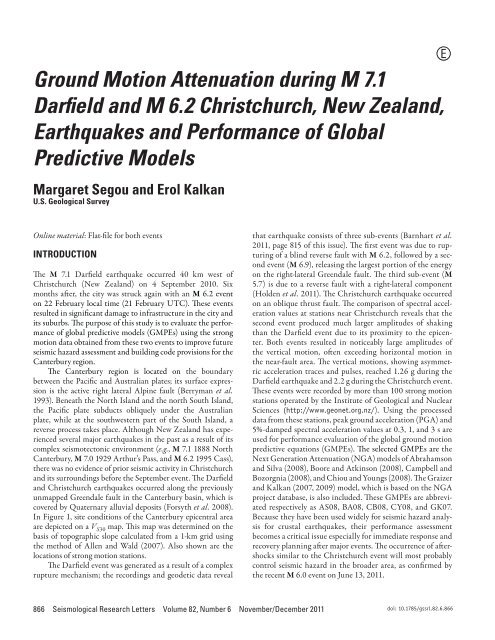Here - Stuff
Here - Stuff
Here - Stuff
Create successful ePaper yourself
Turn your PDF publications into a flip-book with our unique Google optimized e-Paper software.
Ground Motion Attenuation during M 7.1Darfield and M 6.2 Christchurch, New Zealand,Earthquakes and Performance of GlobalPredictive ModelsMargaret Segou and Erol KalkanMargaret Segou and Erol KalkanU.S. Geological SurveyEOnline material: Flat-file for both eventsINTRODUCTIONThe M 7.1 Darfield earthquake occurred 40 km west ofChristchurch (New Zealand) on 4 September 2010. Sixmonths after, the city was struck again with an M 6.2 eventon 22 February local time (21 February UTC). These eventsresulted in significant damage to infrastructure in the city andits suburbs. The purpose of this study is to evaluate the performanceof global predictive models (GMPEs) using the strongmotion data obtained from these two events to improve futureseismic hazard assessment and building code provisions for theCanterbury region.The Canterbury region is located on the boundarybetween the Pacific and Australian plates; its surface expressionis the active right lateral Alpine fault (Berryman et al.1993). Beneath the North Island and the north South Island,the Pacific plate subducts obliquely under the Australianplate, while at the southwestern part of the South Island, areverse process takes place. Although New Zealand has experiencedseveral major earthquakes in the past as a result of itscomplex seismotectonic environment (e.g., M 7.1 1888 NorthCanterbury, M 7.0 1929 Arthur’s Pass, and M 6.2 1995 Cass),there was no evidence of prior seismic activity in Christchurchand its surroundings before the September event. The Darfieldand Christchurch earthquakes occurred along the previouslyunmapped Greendale fault in the Canterbury basin, which iscovered by Quaternary alluvial deposits (Forsyth et al. 2008).In Figure 1, site conditions of the Canterbury epicentral areaare depicted on a V S30 map. This map was determined on thebasis of topographic slope calculated from a 1-km grid usingthe method of Allen and Wald (2007). Also shown are thelocations of strong motion stations.The Darfield event was generated as a result of a complexrupture mechanism; the recordings and geodetic data revealthat earthquake consists of three sub-events (Barnhart et al.2011, page 815 of this issue). The first event was due to rupturingof a blind reverse fault with M 6.2, followed by a secondevent (M 6.9), releasing the largest portion of the energyon the right-lateral Greendale fault. The third sub-event (M5.7) is due to a reverse fault with a right-lateral component(Holden et al. 2011). The Christchurch earthquake occurredon an oblique thrust fault. The comparison of spectral accelerationvalues at stations near Christchurch reveals that thesecond event produced much larger amplitudes of shakingthan the Darfield event due to its proximity to the epicenter.Both events resulted in noticeably large amplitudes ofthe vertical motion, often exceeding horizontal motion inthe near-fault area. The vertical motions, showing asymmetricacceleration traces and pulses, reached 1.26 g during theDarfield earthquake and 2.2 g during the Christchurch event.These events were recorded by more than 100 strong motionstations operated by the Institute of Geological and NuclearSciences (http://www.geonet.org.nz/). Using the processeddata from these stations, peak ground acceleration (PGA) and5%-damped spectral acceleration values at 0.3, 1, and 3 s areused for performance evaluation of the global ground motionpredictive equations (GMPEs). The selected GMPEs are theNext Generation Attenuation (NGA) models of Abrahamsonand Silva (2008), Boore and Atkinson (2008), Campbell andBozorgnia (2008), and Chiou and Youngs (2008). The Graizerand Kalkan (2007, 2009) model, which is based on the NGAproject database, is also included. These GMPEs are abbreviatedrespectively as AS08, BA08, CB08, CY08, and GK07.Because they have been used widely for seismic hazard analysisfor crustal earthquakes, their performance assessmentbecomes a critical issue especially for immediate response andrecovery planning after major events. The occurrence of aftershockssimilar to the Christchurch event will most probablycontrol seismic hazard in the broader area, as confirmed bythe recent M 6.0 event on June 13, 2011.866 Seismological Research Letters Volume 82, Number 6 November/December 2011 doi: 10.1785/gssrl.82.6.866
















